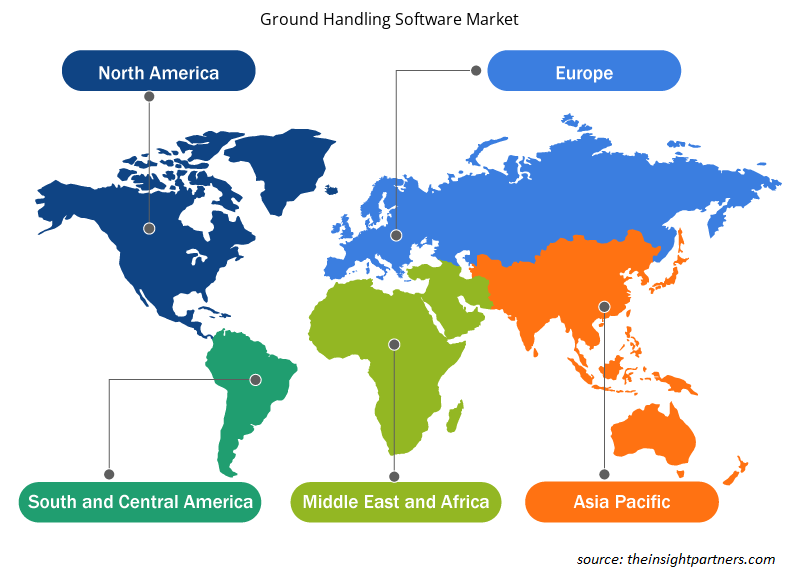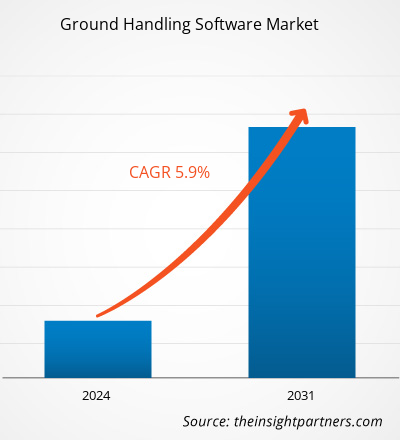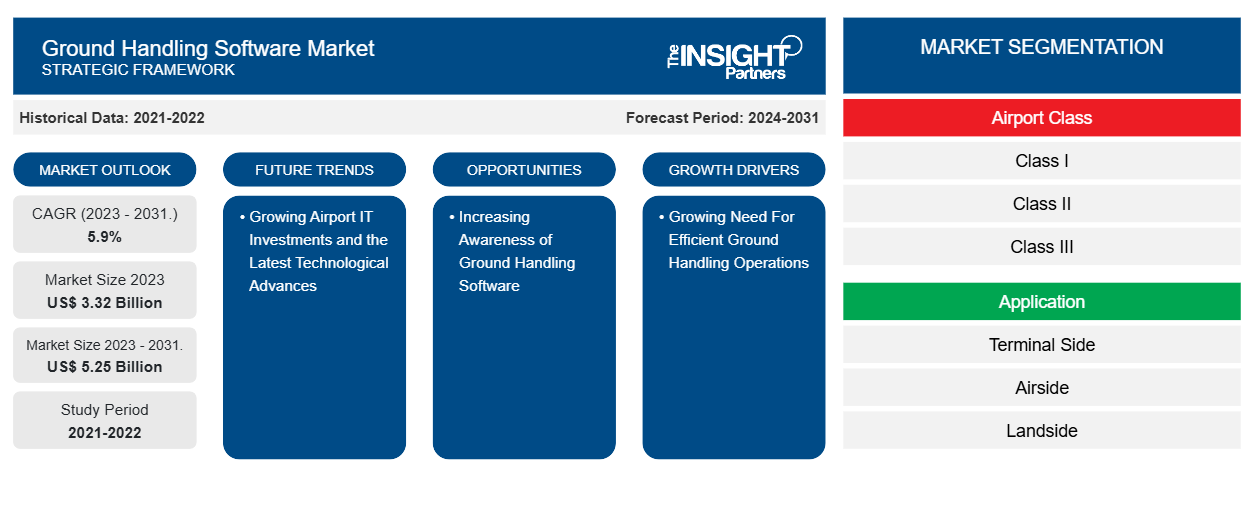Der Markt für Bodenabfertigungssoftware soll von 3,32 Milliarden US-Dollar im Jahr 2023 auf 5,25 Milliarden US-Dollar im Jahr 2031 anwachsen. Der Markt wird zwischen 2023 und 2031 voraussichtlich eine durchschnittliche jährliche Wachstumsrate von 5,9 % verzeichnen. Wachsende Investitionen in die Flughafen-IT und die neuesten technologischen Fortschritte werden voraussichtlich weiterhin ein wichtiger Trend auf dem Markt bleiben.
Marktanalyse für Bodenabfertigungssoftware
Die Nachfrage nach Bodenabfertigungssoftware steigt aufgrund technologischer Durchbrüche und des Wunsches nach einem effizienten Flughafenbetrieb kontinuierlich an. Die Implementierung digitaler Systeme, die Automatisierung, Datenanalyse und Cloud-Computing zur Optimierung der Bodenabfertigungsverfahren umfassen, nimmt zu. Darüber hinaus wird der Drang, neue Technologien und Betriebssysteme in die Branche einzuführen, durch ein strengeres Sicherheitsumfeld und eine verstärkte Selbstbedienungsinteraktion mit Passagieren vorangetrieben.
Marktübersicht für Bodenabfertigungssoftware
Bodenabfertigungssoftware ist ein System, das es ermöglicht, alle am Flugzeug durchgeführten Dienstleistungen schnell und auf die bestmögliche Weise am Boden bereitzustellen. Dazu gehören Dinge wie Betankung, Catering, Gepäckabfertigung und Flugzeugwartung. Bodenabfertigungssoftware ist die ultimative Maßnahme, die den Dienstleistern zusätzlichen Treibstoff und zusätzliche Reisegeschwindigkeit verschafft, was entscheidend ist, um die Umschlagszeit der Flugzeuge zu verkürzen und so den Umsatz zu steigern.
Passen Sie diesen Bericht Ihren Anforderungen an
Sie erhalten kostenlos individuelle Anpassungen an jedem Bericht, einschließlich Teilen dieses Berichts oder einer Analyse auf Länderebene, eines Excel-Datenpakets sowie tolle Angebote und Rabatte für Start-ups und Universitäten.
-
Holen Sie sich die wichtigsten Markttrends aus diesem Bericht.Dieses KOSTENLOSE Beispiel umfasst eine Datenanalyse von Markttrends bis hin zu Schätzungen und Prognosen.
Treiber und Chancen auf dem Markt für Bodenabfertigungssoftware
Wachsender Bedarf an effizienten Bodenabfertigungsabläufen
Die steigende Nachfrage nach einer effizienten Bodenabfertigung an Flughäfen wird durch die Notwendigkeit getrieben, die Betriebskosten zu senken und die Kundenzufriedenheit zu erhöhen. Da die Flughäfen einen alarmierenden Anstieg der Überlastung verzeichnen, suchen Fluggesellschaften derzeit nach Möglichkeiten, die Durchlaufzeiten zu verkürzen, die Genauigkeit der Abfertigungsvorgänge zu verbessern und Verzögerungen zu reduzieren. Bodenabfertigungssoftware ist die Lösung, die es Fluggesellschaften ermöglicht, Bodenaktivitäten problemlos abzuwickeln und so die Betriebskosten zu senken und das Kundenerlebnis zu verbessern. Technologie vereinfacht die Abfertigungsverfahren und hilft einer Fluggesellschaft, sich in einer hocheffizienten und kundenorientierten Betriebsumgebung im Voraus auf die Widrigkeiten des wachsenden Flugverkehrs vorzubereiten.
Steigende Bekanntheit von Ground Handling Software
Das Bewusstsein für die Vorteile, die Bodenabfertigungssoftware durch die Einführung von Automatisierung und Technologie in Bodenabfertigungsvorgängen mit sich bringen kann, wächst weiter. Fluggesellschaften sind sich der Wettbewerbsfähigkeit einer Branche bewusst und suchen nach Möglichkeiten, die betriebliche Produktivität zu verbessern und gleichzeitig die Kosten zu senken, indem sie auf den Preis achten. Bodenabfertigungssoftware bietet Fluggesellschaften die Möglichkeit, den Großteil ihrer Bodenabfertigungsvorgänge zu automatisieren; dies senkt daher die allgemeinen Kosten und verbessert die betriebliche Effizienz. Das wachsende Bewusstsein für diese Vorteile treibt tatsächlich die Einführungsrate von Bodenabfertigungssoftware an Flughäfen voran.
Segmentierungsanalyse des Marktberichts für Bodenabfertigungssoftware
Wichtige Segmente, die zur Ableitung der Marktanalyse für Bodenabfertigungssoftware beigetragen haben, sind Flughafenklasse, Anwendung und Softwaretyp.
- Basierend auf der Flughafenklasse ist der Markt in Klasse I, Klasse II, Klasse III und Klasse IV segmentiert. Das Segment Klasse I hatte im Jahr 2023 einen bedeutenden Marktanteil.
- In Bezug auf die Anwendung ist der Markt in Terminalseite, Luftseite und Landseite segmentiert. Das Segment Terminalseite hatte im Jahr 2023 einen bedeutenden Marktanteil.airside, and landside. The terminal side segment held a significant market share in 2023.
- Basierend auf dem Softwaretyp ist der Markt in Passagier-Ein- und Abflugkontrolle, Gepäckmanagement, automatisierte Fracht- und Ladekontrolle, GSE-Tracking (Telemetrie) und Rampenmanagement segmentiert. Das Segment Gepäckmanagement hielt im Jahr 2023 einen bedeutenden Marktanteil.GSE tracking (telemetry), and ramp management. The baggage management segment held a significant market share in 2023.
Marktanteilsanalyse für Bodenabfertigungssoftware nach geografischer Lage
Der geografische Umfang des Marktberichts zur Bodenabfertigungssoftware ist hauptsächlich in fünf Regionen unterteilt: Nordamerika, Asien-Pazifik, Europa, Naher Osten und Afrika sowie Süd- und Mittelamerika.
Der nordamerikanische Markt für Bodenabfertigungssoftware wächst sprunghaft, da verschiedene Fluggesellschaften und Flughäfen zunehmend nach effizienten und kostengünstigen Bodenabfertigungslösungen verlangen. In dieser Region sind die meisten der größten Fluggesellschaften und Flughäfen der Welt ansässig, die massiv in Bodenabfertigungssoftware investieren, um die Betriebseffizienz zu verbessern und Kosten zu senken. Die Zahl der Anbieter von Bodenabfertigungssoftware in der Region ist gestiegen, was Wettbewerb und Innovation fördert. Insgesamt ist das Wachstum des nordamerikanischen Marktes für Bodenabfertigungssoftware stark – angekurbelt durch die steigende Nachfrage von Fluggesellschaften und Flughäfen nach effizienten und kostengünstigen Bodenabfertigungslösungen, die zunehmende Zahl von Anbietern von Bodenabfertigungssoftware und die Einführung cloudbasierter Lösungen.
Regionale Einblicke in den Markt für Bodenabfertigungssoftware
Die regionalen Trends und Faktoren, die den Markt für Bodenabfertigungssoftware während des gesamten Prognosezeitraums beeinflussen, wurden von den Analysten von Insight Partners ausführlich erläutert. In diesem Abschnitt werden auch Marktsegmente und Geografie für Bodenabfertigungssoftware in Nordamerika, Europa, im asiatisch-pazifischen Raum, im Nahen Osten und Afrika sowie in Süd- und Mittelamerika erörtert.

- Erhalten Sie regionale Daten zum Markt für Bodenabfertigungssoftware
Umfang des Marktberichts für Bodenabfertigungssoftware
| Berichtsattribut | Details |
|---|---|
| Marktgröße im Jahr 2023 | 3,32 Milliarden US-Dollar |
| Marktgröße bis 2031 | 5,25 Milliarden US-Dollar |
| Globale CAGR (2023 - 2031.) | 5,9 % |
| Historische Daten | 2021-2022 |
| Prognosezeitraum | 2024–2031 |
| Abgedeckte Segmente |
Nach Flughafenklasse
|
| Abgedeckte Regionen und Länder |
Nordamerika
|
| Marktführer und wichtige Unternehmensprofile |
|
Dichte der Marktteilnehmer für Bodenabfertigungssoftware: Die Auswirkungen auf die Geschäftsdynamik verstehen
Der Markt für Bodenabfertigungssoftware wächst rasant, angetrieben durch die steigende Nachfrage der Endnutzer aufgrund von Faktoren wie sich entwickelnden Verbraucherpräferenzen, technologischen Fortschritten und einem größeren Bewusstsein für die Vorteile des Produkts. Mit steigender Nachfrage erweitern Unternehmen ihr Angebot, entwickeln Innovationen, um die Bedürfnisse der Verbraucher zu erfüllen, und nutzen neue Trends, was das Marktwachstum weiter ankurbelt.
Die Marktteilnehmerdichte bezieht sich auf die Verteilung der Firmen oder Unternehmen, die in einem bestimmten Markt oder einer bestimmten Branche tätig sind. Sie gibt an, wie viele Wettbewerber (Marktteilnehmer) in einem bestimmten Marktraum im Verhältnis zu seiner Größe oder seinem gesamten Marktwert präsent sind.
Die wichtigsten auf dem Markt für Bodenabfertigungssoftware tätigen Unternehmen sind:
- Arepo Solutions Ltd.
- Avtura Limited
- Damarel Systems International Ltd.
- INFORM GmbH
- Quantum Aviation Lösungen
- Quonext
Haftungsausschluss : Die oben aufgeführten Unternehmen sind nicht in einer bestimmten Reihenfolge aufgeführt.

- Überblick über die wichtigsten Akteure auf dem Markt für Bodenabfertigungssoftware
Neuigkeiten und aktuelle Entwicklungen zum Markt für Bodenabfertigungssoftware
Der Markt für Bodenabfertigungssoftware wird durch die Erhebung qualitativer und quantitativer Daten nach Primär- und Sekundärforschung bewertet, die wichtige Unternehmensveröffentlichungen, Verbandsdaten und Datenbanken umfasst. Nachfolgend sind einige der Entwicklungen auf dem Markt für Bodenabfertigungssoftware aufgeführt:
- Menzies Aviation, der führende Servicepartner der Flughäfen und Fluggesellschaften weltweit, hat gemeinsam mit dem führenden Technologiedienstleistungs- und Beratungsunternehmen Wipro die erfolgreiche Einführung seines neuen Frachtmanagementsystems Menzies Aviation Cargo Handling (MACH) bekannt gegeben.
(Quelle: Menzies Aviation Limited, Unternehmenswebsite, Dezember 2023)
Marktbericht zu Bodenabfertigungssoftware – Umfang und Ergebnisse
Der Bericht „Marktgröße und Prognose für Bodenabfertigungssoftware (2021–2031)“ bietet eine detaillierte Analyse des Marktes, die die folgenden Bereiche abdeckt:
- Marktgröße und Prognose für Bodenabfertigungssoftware auf globaler, regionaler und Länderebene für alle wichtigen Marktsegmente, die im Rahmen des Berichts abgedeckt sind
- Markttrends für Bodenabfertigungssoftware sowie Marktdynamik wie Treiber, Einschränkungen und wichtige Chancen
- Detaillierte PEST/Porters Five Forces- und SWOT-Analyse
- Marktanalyse für Bodenabfertigungssoftware mit Blick auf wichtige Markttrends, globale und regionale Rahmenbedingungen, wichtige Akteure, Vorschriften und aktuelle Marktentwicklungen
- Branchenlandschaft und Wettbewerbsanalyse, einschließlich Marktkonzentration, Heatmap-Analyse, prominenten Akteuren und aktuellen Entwicklungen auf dem Markt für Bodenabfertigungssoftware
- Detaillierte Firmenprofile
- Historische Analyse (2 Jahre), Basisjahr, Prognose (7 Jahre) mit CAGR
- PEST- und SWOT-Analyse
- Marktgröße Wert/Volumen – Global, Regional, Land
- Branchen- und Wettbewerbslandschaft
- Excel-Datensatz
Aktuelle Berichte
Verwandte Berichte
Erfahrungsberichte
Grund zum Kauf
- Fundierte Entscheidungsfindung
- Marktdynamik verstehen
- Wettbewerbsanalyse
- Kundeneinblicke
- Marktprognosen
- Risikominimierung
- Strategische Planung
- Investitionsbegründung
- Identifizierung neuer Märkte
- Verbesserung von Marketingstrategien
- Steigerung der Betriebseffizienz
- Anpassung an regulatorische Trends























 Kostenlose Probe anfordern für - Markt für Bodenabfertigungssoftware
Kostenlose Probe anfordern für - Markt für Bodenabfertigungssoftware